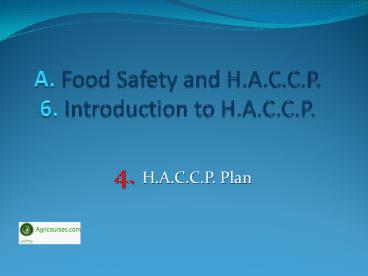Lecture 4: H.A.A.C.P. plan - PowerPoint PPT Presentation
1 / 12
Title:
Lecture 4: H.A.A.C.P. plan
Description:
This lesson put emphasis on food safety requirements, pathogenic microorganisms and foods, basic rules for food preparation, staff obligations, food contamination and staff, food safety hazards, advantages of H.C.C.C.P. – PowerPoint PPT presentation
Number of Views:14
Slides: 13
Provided by:
Username withheld or not provided
Category:
How To, Education & Training
Tags:
Title: Lecture 4: H.A.A.C.P. plan
1
A. Food Safety and H.A.C.C.P.6. Introduction to
H.A.C.C.P.
4. H.A.C.C.P. Plan
2
HACCP plan
- List of the HACCP team and assigned
responsibilities - Description of finished product, including its
distribution, intended use and target consumer - List of product ingredients and incoming
materials - Plant schematic
- Verified flow diagram
- List of hazards identified
- Critical control point determination - decision
tree - HACCP Plan Summary Table that includes
information for - Steps in the process that are critical control
points - The hazard(s) of concern
- Critical limits
- Monitoring
- Corrective actions
- Verification procedures and schedule
- Record keeping procedures
3
Developing a HACCP plan
- 1. Establish a HACCP team
- it is important that the HACCP team is made up
of people from a wide range of disciplines. The
team should include - composition of the HACCP team
- tasks of responsibility
- training of members of the HACCP team
- support from the company management
- 2 - Describe the product
- To start a hazard analysis, a full description of
the product, including customer specification, is
needed - This should include
- information relevant to safety, e.g. mycotoxin
regulation/target level, composition,
physical/chemical properties of the raw materials
and the final product, the amount of water
available for microbiological growth (aw), the
amount of acid or alkali in the product (pH). - information regarding how the product is to be
packaged, stored and transported (labelling
information and an example of the label should be
included)
4
Developing a HACCP plan I
- 3 - Identify the product's intended use
- How the product is intended to be used
- Information on whether the product will be
consumed directly, or be cooked, or be further
processed, will all have a bearing on the hazard
analysis - 4 - Draw up the commodity flow diagram
- The first function of the team is to draw up a
detailed commodity flow diagram (CFD) of the
commodity system, or that part of it which is
relevant - The expertise of the commodity specialist is
important at this stage
5
Developing a HACCP plan II
- 5 - On site confirmation of flow diagram
- Information such as time of harvest, drying
procedures, storage conditions, the marketing
chain, are necessary - The site for which the HACCP plan is being
designed should be visited as many times as
possible to ensure that all relevant information
has been collected - 6 - Identify and analyse hazard(s) - (Principle
1) - Effective hazard identification and hazard
analysis are the keys to a successful HACCP Plan - All real or potential hazards that may occur in
each ingredient and at each stage of the
commodity system should be considered.
6
Developing a HACCP plan III
- 7 - Determine the critical control points (ccps)
- (Principle 2) - Each step in the commodity flow diagram, within
the scope of the HACCP study, should be taken in
turn and the relevance of each identified hazard
should be considered - The team must determine whether the hazard can
occur at this step, and if so whether control
measures exist - If the hazard can be controlled adequately, and
is not best controlled at another step, and is
essential for food safety, then this step is a
CCP for the specified hazard
7
Developing a HACCP plan IV
- 8 - Establish critical limits for each ccp -
(Principle 3) - Critical limits must be specified and validated
for each CCP - We must include measurements of temperature,
time, moisture level, pH, water activity, and
sensory parameters such as visual appearance - All critical limits, and the associated
permissible tolerances, must be documented in the
HACCP Plan Worksheet, and included as
specifications in operating procedures and work
instructions
8
Developing a HACCP plan V
- 9 - Establish a monitoring procedure - (Principle
4) - It can be carried out by observation or by
measurement, on samples taken in accordance with
a statistically based sampling plan. - monitoring by visual observation is basic but
gives rapid results, and can therefore be acted
upon quickly - the most common measurements taken are time,
temperature and moisture content
9
Developing a HACCP plan VI
- 10 - Establish corrective action - (Principle 5)
- The corrective action must also be based on the
assessment of hazards, risk and severity, and on
the final use of the product - Operatives responsible for monitoring CCPs
should be familiar with and have received
comprehensive training in how to effect a
corrective action.
10
Developing a HACCP plan VII
- 11 - Verify the HACCP plan - (Principle 6)
- the HACCP plan must be verified and reviewed at
regular intervals - This includes
- collecting samples for analysis by a method
different from the monitoring procedure - asking questions of staff, especially CCP
monitors - observing operations at CCPs
- formal audit by independent person
11
Developing a HACCP plan VIII
- 12 - Keep records - (Principle 7)
- It demonstrates that the correct procedures have
been followed from beginning to end of the
process, offering product traceability. - It provides a record of compliance with the
critical limits set, and can be used to identify
problem areas
12
Summary of 4thLecture
- The H.A.C.C.P. Plan
- Developing a H.A.C.C.P. Plan































